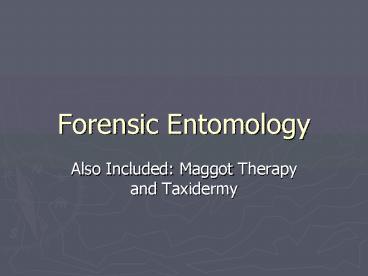Forensic Entomology - PowerPoint PPT Presentation
1 / 38
Title:
Forensic Entomology
Description:
The Most Common Application Relates to Death Investigations ... Five Stages of Human Decomposition Have Been Recognized -1 ... Five Stages ... 4. Postdecay ... – PowerPoint PPT presentation
Number of Views:111
Avg rating:3.0/5.0
Title: Forensic Entomology
1
Forensic Entomology
- Also Included Maggot Therapy and Taxidermy
2
Forensic Entomology Relies Strongly on the
Following Ecological Concepts
- Developmental time is temperature dependant at
the microhabitat level. - Ecological succession A corpse will be invaded
by a series of different species or insect groups
over time. Each species or group changes the
microenvironment through its activities which
makes it attractive to new waves of organisms and
so on.
3
Forensic Entomology is Involved With Arthropod
Involvement in Events Surrounding Felonies
- Violent Crimes
- murder, suicide and rape
- physical abuse
- contraband trafficking
4
The Most Common Application Relates to Death
Investigations
- Determining PMI postmortem interval
- Movement of the corpse
- Manner and cause of death
- Association of suspects with the death scene
- Detection of toxins or drugs through analysis of
insect larvae
5
Estimates of PMI Using Insects May Be Based On
- Period of time for a given species to reach a
particular stage of development - Comparisons of assemblages of insect fauna on
corpse at time of examination - A combination of both above
6
Most Important Environmental Factors in Corpse
Decay
- Temperature
- Access by insects
- Depth of Burial
- Based on study of decay rates of 150 human
corpses at U. of Tenn.
7
Rcological Roles of Insects in Decompositon
- Necrophages species feeding on corpse tissue
mostly true flies and beetles age determination
(larval instar) important for PMI - Omnivores insects that feed both on the corpse
and associated fauna ants, wasps and some
beetles may alter rate of decomposition - Parasites and Predators many beetles, true
flies and wasps that attack immature flies - Incidentals use the corpse as a resource
extension springtails, spiders, centipedes, some
mites
8
Five Stages of Human Decomposition Have Been
Recognized -1
- Fresh Stage (Days 1-2) From moment of death to
first sign of bloating flesh flies, blow flies,
ants eating fly eggs and predatory wasps
9
Flesh Flies 2 Species
10
Two Blowfly Species
11
Blowfly Larvae
12
House Flies on Dead Host
13
Five Stages 2
- Bloated stage (Days 2-6) putrefaction begins
gases produced by anaerobic bacteria
considerable bloating seepage of fluids adult
and larval blowflies attracted in large numbers
to seepage soil fauna moves away due to wetness
of earth ants and other species of flies prey on
maggots
14
Five Stages 3
- Decay Stage (Days 5-11) Abdominal wall is
broken and carcass deflates adult flies begin to
leave but great masses of maggots remain and
feed carcass will begin to dry and beetles begin
feeding on drier tissue flies start to pupate
predatory beetles such as rove and hister beetles
are attracted
15
Pig Carcass Infested With Blowfly Maggots
16
Hister Beetles Prey on Blowfly Larvae
17
Rove Beetles 2 Species
18
Five Stages 4
- Postdecay Stage (Days 10-25)
- in dry habitats - remains consist of dry skin,
cartilage and bones site for dermestid beetles,
histerids, fly pupae, immature and adult rove
beetles - in wet habitats large quantities of wet,
viscous material (byproducts of decomposition)
found in soil under the remains site for adult
and immature moth flies, rove beetles
19
Dermestid Beetles Adult and Larvae
20
Five Stages 5
- Dry Stage (Days 25) Mainly bone and hair is
all that remains odor is primarily that of soil
and litter some dermestids, fly pupae, immature
and adult rove beetles, normal soil fauna
consisting of mites, etc. start to return this
stage could last for several months to years
21
Carrion Beetles 2 Species
22
Female Carrion Beetle and Kangaroo Rat
Rat will be completely buried and eggs laid upon
it.
23
Barriers to Decomposition and Irregular
Decomposition
- Physical soil, water, caskets, antermortem and
postmotem injuries - Chemical embalming agent, insecticides, lime,
etc. - Climatic heat, cold, wind, rainfall
- Animals bird, mice, rodents, canids, cats, etc.
24
Maggot Therapy Technically called Maggot
Debridement Therapy or MDT
Fly larvae are used to scavenge on dead tissue
associated with a wound. Fly larvae excrement,
termed allantoin has a high ammonia content
which appears to serve as an antibiotic.
25
Wounds on the Battlefield in World War II
It has been noted by war surgeons that wounds
incurred by troops in which fly larvae were
feeding had much less gangrene and healed more
quickly than wounds that were protected from
flies
26
Phaenicia sericata the green blow fly. This
species feeds only on necrotic (decayed) tissue.
27
Interesting and True
- Maggot therapy is much more commonly used in
Great Britain and Europe than in the U.S. - There have been about 25,000 treatments in Great
Britain since 1995. - Ronald Sherman, M.D. is the pioneer of maggot
therapy in the U.S. He is located at U. of
Calif., Irvine.
28
Maggots Feeding at Edge of an Ulcerating Wound on
Foot
29
Maggots Cleaning Up a Wound Associated with an
Amputation
30
Vertebrate Biology/Taxidermy Skull and Skelton
Preparation
31
A Skull Cleaned by Dermestid Beetles
32
Trays of Vertebrate Skulls in Dept. Of Vertebrate
Biology, Univ. of Michigan
33
A Great Horned Owl Skeleton
34
Dermestid Colony Housing
35
Larval and Adult Dermestids Working on Jawbone
36
Bears Skull Being Cleaned
37
Dermestid Beetles Are Economic Pests and Will
Scavenge on Anything Organic of Both Plant and
Animal Origin
- Destroy woolen carpets, upholestry and rugs
- Consume insects on pins in museum and university
collections - Stored furs, leather and skins
- Meat, cheese and stored products
- Materials made of silk
38
Dermestids are Beneficial in Terms of
- Their use in vertebrate skull/skeleton
collections - Their forensic use as we have seen































